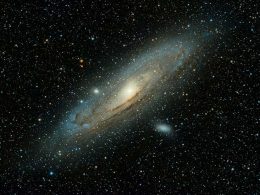On February 6, 1971, NASA astronaut Alan B. Shepard was part of the Apollo 14 mission that landed on the moon. During that historic trip, he took a swing against two golf balls to serve as a memorial, Daily Mail writes.
However, while one ball went just 24 yards away from Shepard to rest on a crater, the whereabouts of the golf ball was unknown. This particular incident prompted a debate among many on how far the golf ball went. Shepard himself had claimed his golf ball traveled miles. It seemed the mystery that puzzled many is now solved, courtesy of imaging expert Andy Saunders.
Saunders undertook a digital enhancement of the images and was able to estimate how far the golf ball traveled. To commemorate the fiftieth anniversary of that mission, Saunders released his findings to the public via Twitter. He concluded the first golf ball from Shepard traveled only 24 yards, while the NASA astronaut was able to increase his tally by 40 yards for the second golf ball.
Since his days as a Naval pilot, Shepard has been fond of making groundbreaking but frivolous accomplishments. One of such acts had nearly gotten him into trouble with his superiors. With the establishment of NASA in 1959, he was chosen as one of the astronauts. He was part of the Apollo 14 mission of 1971.
His famed stunt on the moon was to showcase to people watching back on Earth the difference in gravity between the two orbital bodies. He had a makeshift golf club designed for him, alongside two golf balls, which he smuggled into space. However, years later, Shepard corrected the widely-held impression that he smuggled the golf kits into space. He explained that his superiors authorized the move after having initially rejected the idea.
With every official exploration task completed, Shepard settled down to putting his stunt into action. On February 6, he brought out his golf kits to attempted swinging. His spacesuit was too bulky and cluttered, so Shepard settled with having to take a swing with just one hand. After many attempts, he got his swing right. While one ball flew into a nearby crater, the other was nowhere to be seen. Shepard declared it must have traveled miles, only to be proved wrong by Saunders.
Saunders’ expertise with remodifying archival photos made it possible for him to locate Shepard’s second golf ball. The only footage from the mission released by NASA was unclear. But Saunders, being the expert that he is, used an image processing method known as subtacking to find the second ball.
While many had expected Shepard’s ball to travel wide considering the low gravity, Saunders praised the astronaut’s efforts considering the constraints he had to overcome. He said the fact that Shepard struck at the ball despite the hindrances was impressive.
Saunders talks more about Shepard’s famed golf swing in his forthcoming book titled Apollo Remastered.
Source: dailymail.co.uk









